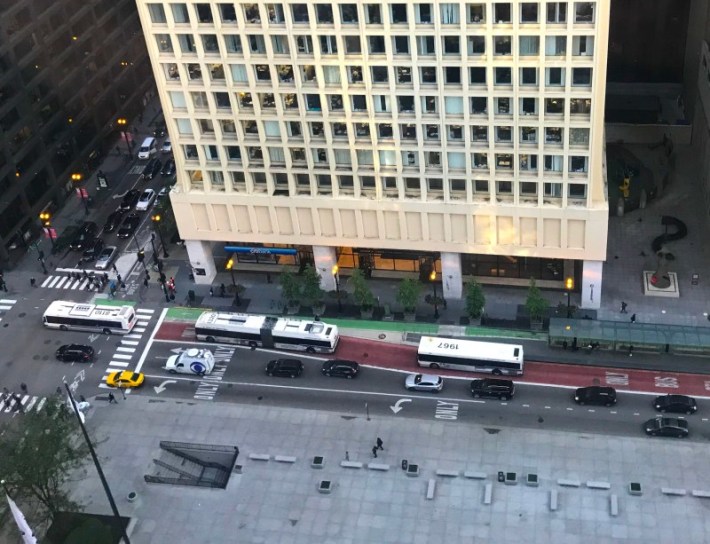In 2015 when I toured San Francisco on bikes with then-Streetsblog SF editor Aaron Bialick, I was impressed by the people-friendly layout of Market Street, the bustling central thoroughfare that's the City by the Bay's answer to Chicago's Michigan Avenue. On some stretches of the street, two of the six travel lanes had been painted solid green for wide bike lanes, and another two had been painted solid red as dedicated bus and taxi lanes. That setup made sense, since up to seventy-five percent of weekday vehicle traffic on the street was bicycles. Private vehicles were still permitted in the remaining two lanes.
Fast forward four years, and SF has just made the bold decision to make Market completely car-free, showing the path forward for the rest of America's great cities, including ours. As reported by the San Francisco Chronicle's Rachel Swan, on Tuesday the city's Municipal Transportation Agency board voted unanimously to ban private cars from the street, with support from just about every faction: including bike advocates, families, healthcare professionals, merchants, ride-hail companies, and the mayor.
The plan has been in the works for almost a decade, and construction will begin in January to change the street design for the ban on private cars on Market east of Tenth Street, the Chronicle reported. Commercial loading will only be permitted during certain hours, the bus-only lane will be extended from Third to Market Street, and sidewalks will be widened. A raised bike lane will be constructed with curb protection. Workers will also build a new streetcar loop. Private car drivers will be allowed to cross Market at intersections, but not drive on it.
“It’s almost astonishing how well supported this is,” SFMTA board chair Malcolm Heinicke said during the hearing. “Not just because it’s going to be beautiful and there will be trees. It’s supported because it will save people’s lives.” According to the Chronicle, Market sees 500,000 walking trips a day and 650 bike riders per hour during rush periods, as well as many pedestrian and bike crashes.
Swan noted that, in a city known for wealth inequalities, the new setup with make Market more democratic. Cyclist will have a safe bike lane all the way downtown, and Muni buses filled with dozens of people won't get stuck behind single-passenger ride-hailing vehicles. Brian Wiedenmeier, executive director of the San Francisco Bicycle Coalition, said as much: “Market Street is by design our central boulevard, and it could be ... a street that reflects the best of our values: community justice, sustainability, elevating people and their daily experience above cars getting someplace quickly.”
So why don't we make Michigan Avenue safer, more efficient, and more democratic as well? As it stands the street is up to eight lanes wide downtown, but there are no dedicated transit lanes and virtually no bike lanes, save for a block of northbound bikeway between Washington and Randolph streets. CTA buses get stuck in traffic created by single-occupant vehicles, ride-hail cars, and taxis.
Although it's Chicago's flagship pedestrian shopping street, Michigan has mediocre conditions for walking. For example, to facilitate driving at Michigan/Randolph, those walking from the Chicago Cultural Center at the southwest corner of the intersection, to Millennium Park at the southeast corner, are required to make three street crossings when they should only need to cross one. People walking on the west side of the Magnificent Mile (Michigan north of the river), are endangered by drivers turning west off of Michigan, who get a turn arrow after the light on Michigan turns green.
The fact that Michigan's moto vehicle-centric status-quo is dangerous to vulnerable road users was laid bare in November 2015, when a tour bus operator failed to yield while making a right turn, killing Hiromi Hosono, 42, an agriculture professor from Japan who was crossing the avenue in a crosswalk with a walk signal.
I'm certainly not the first person to propose making Michigan car-free or car-lite. A few years ago urban planner Shaun Jacobsen floated a "car-free Boule Mich" scheme, which would have banned traffic on Michigan, as well as cross-traffic. That helped inspire the Active Transportation Alliance to include Michigan on a list of 20 potential streets for partial or full car bans, released in early 2014. (Unfortunately the Active Trans post with the list is currently offline.)
Mayoral aide David Spielfogel was quick to pour water on the idea of banning private cars on Michigan. "Shutting an entire street like Michigan Avenue is not something [Mayor Rahm Emanuel] would be very supportive of,” Spielfogel said. “It seems like a drastic change... It doesn't make sense."

Of course, not long after that the city of Chicago dedicated multiple lanes of several downtown streets for bus and bike use as part of the Loop Link express bus corridor project, which seemed like a crazy idea to many Chicagoans when it was first announced. While the time-savings have been modest for various reasons, including the ride of ride-hail and lax bus lane enforcement, the street remix has made Loop thoroughfares like Washington Street safer and more pleasant. And current mayor Lori Lightfoot wants to pass legislation to allow camera enforcement of bus lanes, which would make them function much better, unclogged by unauthorized vehicles.
So even if the time isn't ripe for totally banning cars on Michigan, San Francisco style, what's keeping us from converting some of the many lanes on Michigan to transit and bike lanes? Doing so would move a greater number of people more efficiently through the corridor, reduce crashes, and make the Mag Mile a nicer place to stroll and shop.






